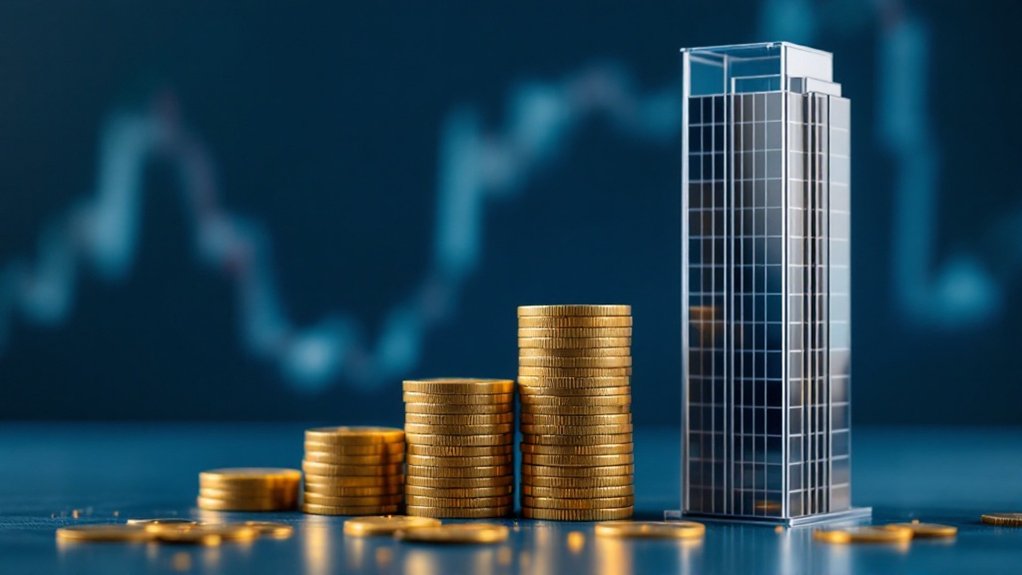Market capitalization is Wall Street’s way of sizing up companies, plain and simple. It’s calculated by multiplying a company’s stock price by its total outstanding shares – basically a financial popularity contest with real consequences. Big market caps usually mean stable behemoths like Apple or Microsoft, while smaller caps could be scrappy upstarts with room to grow. But market cap isn’t perfect – it’s just one piece of a much bigger corporate puzzle.

Money talks, and market capitalization speaks volumes about a company’s worth. In its simplest form, market cap is just basic multiplication – take the total number of outstanding shares and multiply by the current stock price. Boom. You’ve got yourself a number that tells you exactly how much the market thinks a company is worth. It’s like a financial popularity contest, but with real consequences. Analyzing market cap helps investors determine if a company’s equity value is stable.
Companies come in different sizes, just like coffee cups at your local café. You’ve got your mega-caps, the corporate giants worth over $200 billion – think tech behemoths and global conglomerates. Then there are the large-caps, sitting pretty at $10 billion plus. Mid-caps occupy the middle ground, while small-caps and micro-caps round out the bottom of the corporate food chain. Common stock holders can influence company decisions through their voting rights.
Smaller doesn’t mean worse, though. Sometimes it just means more room to grow.
The fascinating thing about market cap is how quickly it can change. Stock prices bounce around like a kangaroo on caffeine, directly affecting a company’s market cap. Companies can also mess with their market cap by issuing new shares or buying them back. It’s like a corporate game of musical chairs, except with billions of dollars at stake.
Market cap isn’t just a fancy number for bragging rights. It’s an essential tool for comparing companies and evaluating their stability. Big market caps usually mean established companies with steady returns but limited growth potential. Small market caps? More volatility, but possibly more excitement if things go well.
Here’s the kicker – while market cap helps calculate a company’s total value, it doesn’t directly control stock prices. Those are determined by good old-fashioned supply and demand, along with a healthy dose of market psychology.
Think of market cap as a snapshot of a company’s size at any given moment. It’s not perfect, but it’s one of the most straightforward ways to size up a company’s presence in the market. Sometimes the simplest metrics tell the best stories.
Frequently Asked Questions
How Often Does a Company’s Market Capitalization Change During Trading Hours?
A company’s market capitalization changes continuously during trading hours, fluctuating with each stock price movement, which can occur multiple times per second based on market activity and trades.
Can Market Capitalization Predict a Company’s Future Stock Performance?
Market capitalization alone cannot predict future stock performance. While it indicates company size and stability, multiple factors including earnings, market conditions, and industry trends determine actual stock movements.
Why Do Some Companies Deliberately Maintain Lower Market Caps?
Companies maintain lower market caps to attract potential acquirers, remain nimble in decision-making, reduce regulatory scrutiny, and preserve flexibility for rapid strategic changes in their business operations.
How Do Stock Splits Affect a Company’s Market Capitalization?
Stock splits do not affect a company’s market capitalization, as the total value remains constant while shares multiply and price per share decreases proportionally to maintain the same overall value.
What Role Does Market Capitalization Play in Index Fund Inclusion?
Market capitalization serves as a primary criterion for index fund inclusion, determining eligibility thresholds and weighting within indices. Larger market caps typically lead to greater representation and influence in major indices.





